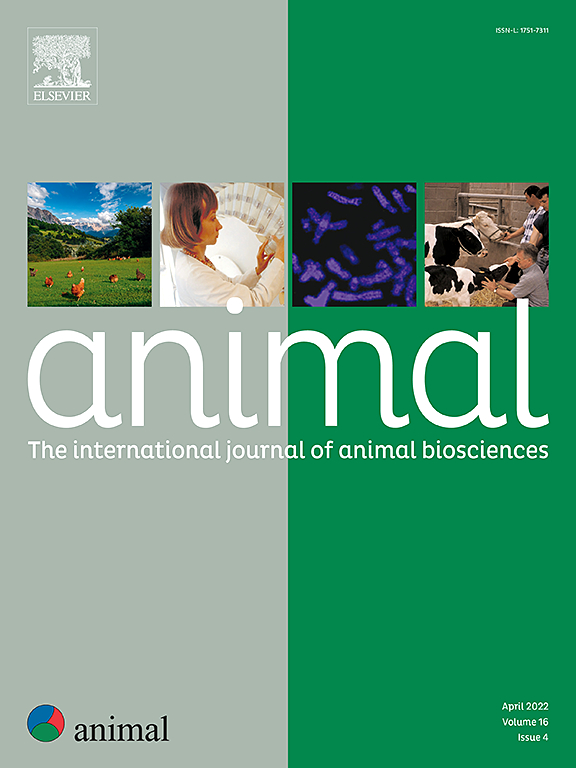The carbon cost of impaired welfare on sheep farms
IF 4
2区 农林科学
Q1 AGRICULTURE, DAIRY & ANIMAL SCIENCE
引用次数: 0
Abstract
In the face of global climate threats, farm and land-management decisions must balance climate concerns with profitability, animal welfare, and ecosystem health. However, few comprehensive studies have quantified the relationship between animal welfare and greenhouse gas (GHG) emissions, and no study focuses specifically on sheep farms. The present study aims to quantify the effects of impaired welfare on GHG emissions for common welfare challenges faced in UK lowland (L) and hill (H) sheep farming systems. Two case study research farms in Scotland, representative of high welfare conditions, were used as baselines for semi-intensive L and extensive H systems. In this study, “high welfare conditions” are defined as situations where animals have access to adequate feeding, suitable housing, good health, and opportunities to express natural behaviours. From each high-welfare baseline, scenarios representing common levels of impaired welfare conditions were modelled, using parameters retrieved from the published literature. The selected poor-welfare scenarios included lameness, gastrointestinal nematodes, blowfly strike, liver fluke, inadequate shelter provision, inadequate feeding during lamb growth and late gestation, and high lamb mortality rate. GHG emissions were estimated “from-cradle-to-farm-gate” using Agrecalc ©, a Life Cycle Assessment tool for the agricultural sector. Total GHG emissions and emission intensities (EI) in kg of CO2 equivalent per kg live weight were compared across the baseline and the scenarios. Gross farm emissions and product-level EIs demonstrated divergent patterns in response to impaired welfare. Most impaired welfare scenarios led to a slight decrease in total farm emissions (0.03–3%), with a few exceptions. On the other hand, EI increased across all impaired welfare scenarios relative to the baseline, because meat production decreased by 1.3–16.6% across all impaired welfare scenarios, reducing resource use efficiency. Lameness was identified as particularly impactful, resulting in 18 and 10% increases in EI on H and L farms, respectively. This was primarily due to the high lamb mortality associated with lameness in published studies. Inadequate shelter provision was associated with an 8–15% increase in EI. Scenarios related to ineffective parasite control contributed to an EI increase ranging from 1 to 13%, while inadequate feeding management caused a 3–4% increase in EI. This study highlights the potential for reducing emission intensity through system-specific interventions, emphasising the importance of integrating animal welfare into GHG mitigation strategies.
羊场福利受损的碳成本。
面对全球气候威胁,农业和土地管理决策必须在气候问题与盈利能力、动物福利和生态系统健康之间取得平衡。然而,很少有综合研究量化动物福利与温室气体(GHG)排放之间的关系,也没有研究专门关注绵羊养殖场。本研究旨在量化福利受损对温室气体排放的影响,以应对英国低地(L)和山地(H)羊养殖系统面临的共同福利挑战。在苏格兰的两个案例研究农场,高福利条件的代表,被用作半集约化L和广泛的H系统的基线。在这项研究中,“高福利条件”被定义为动物能够获得充足的食物、合适的住房、良好的健康状况和表达自然行为的机会的情况。根据每个高福利基线,使用从已发表的文献中检索的参数,对代表常见福利受损状况水平的情景进行建模。所选择的贫困福利情景包括跛行、胃肠道线虫、苍蝇叮咬、肝吸虫、庇护所供应不足、羔羊生长和妊娠后期喂养不足以及羔羊死亡率高。使用农业部门生命周期评估工具Agrecalc©估算了“从摇篮到农场大门”的温室气体排放量。比较了基线和不同情景下的温室气体排放总量和排放强度(以每千克活重二氧化碳当量为单位)。农业总排放量和产品水平的环境影响指数在对福利受损的反应中表现出不同的模式。除少数例外情况外,大多数福利受损情景导致农场总排放量略有下降(0.03-3%)。另一方面,与基线相比,所有福利受损情景的EI都有所增加,因为所有福利受损情景的肉类产量下降了1.3-16.6%,降低了资源利用效率。跛行被认为是特别有影响的,导致H和L农场的EI分别增加18%和10%。这主要是由于在已发表的研究中与跛行相关的羔羊死亡率高。住房供应不足与EI增加8-15%有关。与寄生虫控制无效相关的情景导致EI增加1 - 13%,而喂养管理不当导致EI增加3-4%。这项研究强调了通过系统特定干预措施降低排放强度的潜力,强调了将动物福利纳入温室气体缓解战略的重要性。
本文章由计算机程序翻译,如有差异,请以英文原文为准。
求助全文
约1分钟内获得全文
求助全文
来源期刊

Animal
农林科学-奶制品与动物科学
CiteScore
7.50
自引率
2.80%
发文量
246
审稿时长
3 months
期刊介绍:
Editorial board
animal attracts the best research in animal biology and animal systems from across the spectrum of the agricultural, biomedical, and environmental sciences. It is the central element in an exciting collaboration between the British Society of Animal Science (BSAS), Institut National de la Recherche Agronomique (INRA) and the European Federation of Animal Science (EAAP) and represents a merging of three scientific journals: Animal Science; Animal Research; Reproduction, Nutrition, Development. animal publishes original cutting-edge research, ''hot'' topics and horizon-scanning reviews on animal-related aspects of the life sciences at the molecular, cellular, organ, whole animal and production system levels. The main subject areas include: breeding and genetics; nutrition; physiology and functional biology of systems; behaviour, health and welfare; farming systems, environmental impact and climate change; product quality, human health and well-being. Animal models and papers dealing with the integration of research between these topics and their impact on the environment and people are particularly welcome.
 求助内容:
求助内容: 应助结果提醒方式:
应助结果提醒方式:


